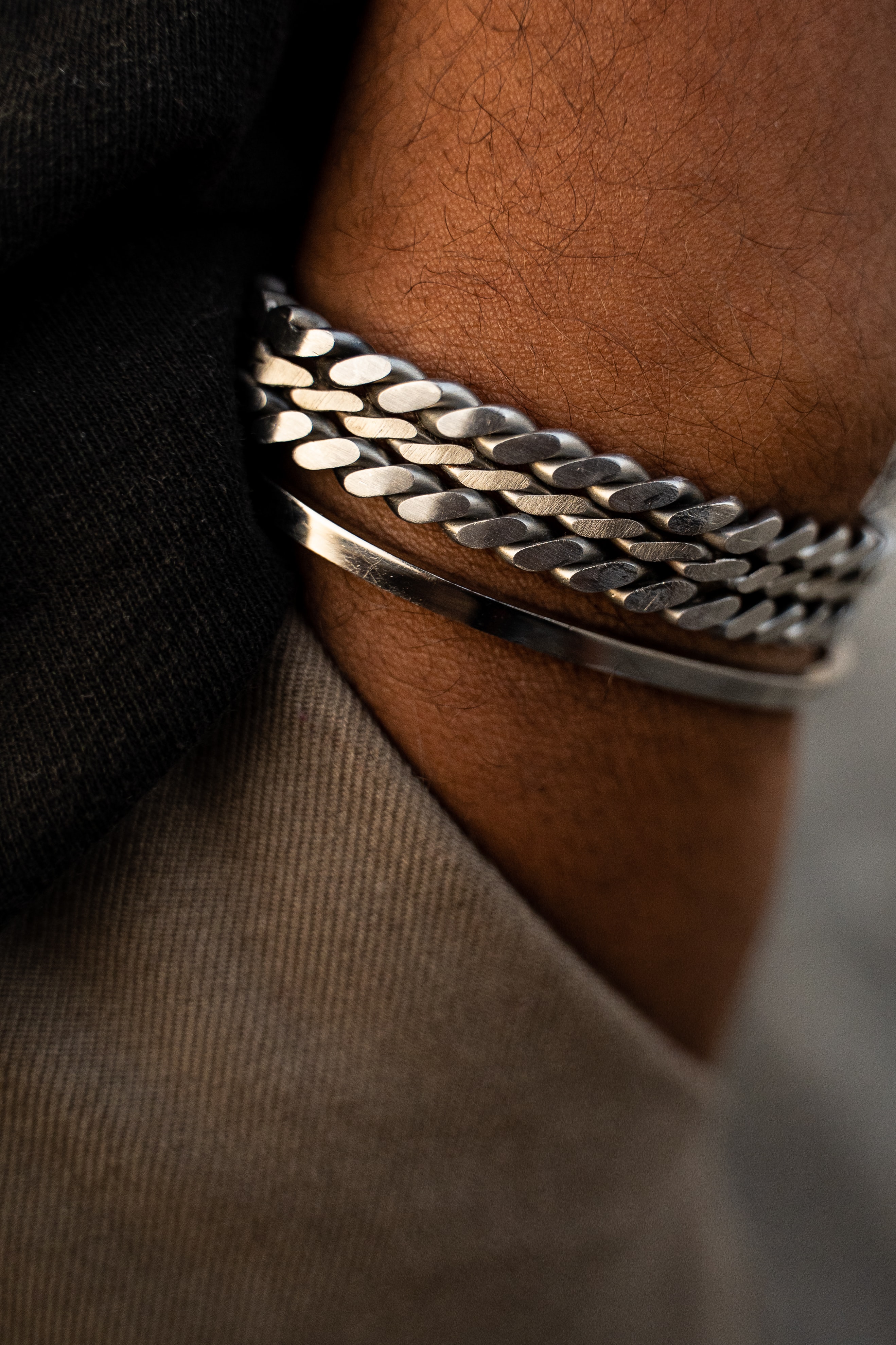Magical Binding
Fortunately for the world, the attempt to bind Vasco Painter's magic ultimately failed. Otherwise, we wouldn't have his research or his art.
Magical Bindings are patterns, most commonly found in the form of bracelets, which contain Magic.
History
Aside from the mysterious rings of Auras, the earliest magical bindings date back to 4th century Brightland. These were primarily metal cuffs with binding patterns etched into them. When locked around a person's wrists, they usually blocked any ability the wearer had to perform magic. The cuffs were used to contain the magic of criminals, so they could not escape their sentencing.
There is also evidence that during this time, a type of rope was used in Nefrale to restrict magic usage, though it did not usually block all ability to use magic. The rope has given way to different forms of magical binding, but Magicologists have determined it was created by spinning particular fibers together and imbuing the rope with intent in the process, as in other varieties of Fabric Magic. It was likely spun in large quantities, so it could be used to bind the magic of an area, by encircling it with the rope, or the magic of an individual, by wrapping it around the body, usually the wrists. The term "wizard rope" is still used today, though it usually refers to a cord knotted in the Brightlindish patterns.
In 1345, while studying the The Rings of Auras, archeaologist Nesrin Knaggs determined that binding patterns could be applied to entire rooms. By making slight alterations, he developed Warding Patterns, which could be turned on or off with a switch, usually a spoken command. These patterns could then be painted or carved into the walls of a room to contain magic within it. While warding patterns were of use in detention centers, they also quickly found traction in schools and hospitals, where magic is more likely to spin out of control and cause damage.
In 1620 Steeldream Sapling of Zenxon developed a classification for binding patterns. He assigned a number to each of the eleven known patterns, with a higher number representing a stronger binding, but he also differentiated between eight binding patterns and three training patterns, which he numbered separately. Training patterns were so called because these binding patterns created a resistance to magic, without fully blocking it. Though some societies already used them to help wizards struggling with control, it was Sapling's classification that led to training bracelets being made worldwide. Furthermore, until this time, most binding studies focused only on finding stronger patterns, but two new training patterns were discovered in the century following Sapling's work.
Binding Patterns Today
No binding pattern is infallible.
People continue to study binding magic today. Magicologists theorize that certain patterns have a natural affinity to produce particular effects. Therefore, binding patterns are typically described as being "discovered," rather than "developed" or "created." The most recent discovery was by Zachary Wood, who found binding pattern 9, almost three hundred years after Sapling classified the original eight patterns. Binding pattern 9 is the strongest binding pattern known to date.
As in the past, criminal bindings today are usually metal cuffs which lock around each wrist. Some have the binding patterns etched into them, though an increasing number are made in the shape of the binding patterns, so that the pattern not be scratched away. Training patterns now take a variety of shapes. Training cuffs can be found made of any material that can be bent into the proper shape. This again, can be metal, as well as knotted cord, or even paper. Many artists have become interested in binding patterns and how to create beautiful, but functional jewelry and wards. Though "designer" binding patterns are much more common in training cuffs and wards, they sometimes enter the criminal sphere. Most notably, Oronian thief Vasco Painter has binding tattoos which include a decorative lock and key motif.
No binding pattern is infallible.
People continue to study binding magic today. Magicologists theorize that certain patterns have a natural affinity to produce particular effects. Therefore, binding patterns are typically described as being "discovered," rather than "developed" or "created." The most recent discovery was by Zachary Wood, who found binding pattern 9, almost three hundred years after Sapling classified the original eight patterns. Binding pattern 9 is the strongest binding pattern known to date.
As in the past, criminal bindings today are usually metal cuffs which lock around each wrist. Some have the binding patterns etched into them, though an increasing number are made in the shape of the binding patterns, so that the pattern not be scratched away. Training patterns now take a variety of shapes. Training cuffs can be found made of any material that can be bent into the proper shape. This again, can be metal, as well as knotted cord, or even paper. Many artists have become interested in binding patterns and how to create beautiful, but functional jewelry and wards. Though "designer" binding patterns are much more common in training cuffs and wards, they sometimes enter the criminal sphere. Most notably, Oronian thief Vasco Painter has binding tattoos which include a decorative lock and key motif.
Children Technologies
Binding Geographically
I hear that on the Minor Continent, they've eliminated bracelets and now just tattoo bindings directly on to people. It's barbaric!
As binding patterns were originally designed on the Minor Continent for the purpose of managing criminals, this remains their primary usage, though training cuffs are sometimes used by parents and teachers. In contrast, in the Southern and Major Continents, training patterns are the primary use of such cuffs. Furthermore, while the full range of binding patterns is frequently used on the Minor Continent, binding patterns 4-9 are rarely used elsewhere. In 1236, Brightland also introduced binding tattoos, in which the pattern was inked directly into the skin, to create a permanant binding. While binding tattoos have been accepted by governments throughout the Minor Continent and Western Islands, it is seen as a violation of human rights in other many other countries.
The rings of Auras are clearly a form of magical binding, though it seems the creators turned them off long ago...





Comments